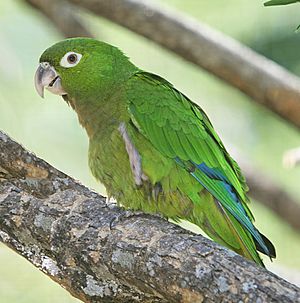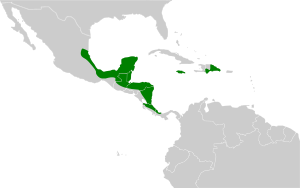Olive-throated parakeet facts for kids
Quick facts for kids Olive-throated parakeet |
|
|---|---|
 |
|
| Eupsittula nana nana | |
| Conservation status | |
| Scientific classification | |
| Genus: |
Eupsittula
|
| Species: |
nana
|
 |
|
| Synonyms | |
|
|
The olive-throated parakeet (Eupsittula nana) is a type of bird in the parrot family. People who keep birds sometimes call it the olive-throated conure. You can find this bird from Mexico all the way to Costa Rica and also in Jamaica. It has also been brought to the Dominican Republic.
Contents
About the Olive-throated Parakeet
Scientists group animals into different families and types. The olive-throated parakeet used to be in a group called Aratinga, but since about 2014, it's been placed in the group Eupsittula.
There are three main types, or subspecies, of the olive-throated parakeet:
- E. n. vicinalis
- E. n. astec
- E. n. nana
Some scientists think that E. n. astec and E. n. nana should be separate species. But for this article, we'll think of them as one species with three different types.
What They Look Like
The "Jamaican" olive-throated parakeet (E. n. nana) is the most common type. It is about 22 to 26 centimeters (9 to 10 inches) long. It weighs about 72 to 85 grams (2.5 to 3 ounces). Both male and female birds look alike.
These birds are mostly dark green on their heads and backs. They have yellowish feathers near their ears and on their lower backs. Around their eyes, they have bare white skin. Their throat and chest are olive-brown, which fades to olive on their belly. Their wings are mostly green, with dull blue on the top side of their flight feathers. The underside of their tail is yellowish. Their beak is brownish, and their eyes are yellow to orange. Young birds look similar to the adults.
The other types of olive-throated parakeets have slight differences. For example, E. n. astec has lighter olive-brown underparts. The E. n. vicinalis type is a bit larger and has brighter green feathers.
Where They Live and Their Homes
The olive-throated parakeet lives in two main areas that are far apart. The E. n. nana type lives naturally in Jamaica and has been introduced to the Dominican Republic. The E. n. vicinalis type lives in northeastern Mexico. The E. n. astec type is found along the Caribbean coast from Mexico through countries like Guatemala, Belize, Honduras, Nicaragua, and Costa Rica.
These parakeets love to live in forests where trees lose their leaves. They also live in humid forests, areas near rivers, and open places like farms and gardens. They can be found in pine tree areas, especially in the Dominican Republic. They live at different heights, from sea level up to about 1,500 meters (4,900 feet) in Jamaica.
How They Behave
Movement
The Jamaican olive-throated parakeets sometimes move between wet and dry areas. They do this to find food. The other two types usually stay in the same place all year. However, the E. n. astec type sometimes visits an island called Caye Caulker in Belize during the winter.
Feeding Habits
A big part of the olive-throated parakeet's diet is fig fruits. They also eat other fruits, leaves, and flowers. In Jamaica, you often see them in groups of up to 20 birds. Sometimes, they eat crops like corn on farms. On the mainland, their groups can be much larger, with 50 or more birds. Sometimes, they even join up with other types of parakeets.
Reproduction and Life Cycle
The Jamaican olive-throated parakeet nests between March and June. In Costa Rica, they nest earlier, from January to April. In Belize and Guatemala, it's usually in April and May. These birds often nest in holes they dig in termite nests. They have also been known to nest in tree holes in Jamaica. A female bird usually lays three to five eggs. We don't know exactly how long the eggs take to hatch or how long it takes for the young birds to fly.
What Their Calls Sound Like
The calls of the different types of olive-throated parakeets are very similar. They make a sharp, scratchy sound like “krik-krik-krik-krik” or a loud “krrieh krrie krreah.”
Their Conservation Status
The IUCN (International Union for Conservation of Nature) looks at the "Jamaican" and "Aztec" olive-throated parakeets separately.
The Jamaican population is considered "Near Threatened." This means they could become endangered soon. There are about 10,000 to 20,000 adult birds, and their numbers are going down. Losing their homes and forests is a big problem for them. Even though they are common in Jamaica, people sometimes hunt them or catch them for pets, which also causes their numbers to drop. However, the population in the Dominican Republic seems to be growing.
The "Aztec" olive-throated parakeet is considered of "Least Concern." This means they are not in immediate danger. They live in a large area, but their population size isn't fully known, and it's thought to be decreasing. They are common in many places and live in protected areas. However, some groups have fewer birds because their homes are being lost. All olive-throated parakeets are listed in CITES Appendix II, which means their trade is controlled to protect them.
See also
 In Spanish: Perico pecho sucio para niños
In Spanish: Perico pecho sucio para niños




